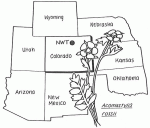Two events that have occurred since Niwot Ridge/Green Lakes Valley was last featured in the Network News (Spring 1988) have reinforced site researchers’ appreciation for the value of long-term research. Both involved relatively rare events of large significance in the context of 10 years of University of Colorado long-term ecological research (CULTER) studies.
Vole Irruption
In the spring of 1988, it became apparent that vole population (Microtus spp.) on Niwot Ridge, and throughout the Front Range, had irrupted during the winter. Reproduction below the winter snow cover led to damage of the tundra vegetation: voles had burrowed through the turf and chewed plants, including cushion plants some of which may have been 100 years old. Vole populations reached a high of 49 voles/hectare (ha)--four times the previously recorded high--but collapsed to 4 voles/ha by 1989.
An emergency response team determined that investigations should center on the animal interactions with the plants and landscape. Field mapping revealed the extent of impacts:
20% of the alpine tundra was heavily chewed with moist plant communities most damaged. By July 1989, the area of new damage had dropped to 2%. Even so, these initial surveys suggest changes in the landscape that may be apparent for decades.
Rainstorm Event
The second event occurred on June 26, 1988 when 52 mm of rain fell in eight hours in the upper Green Lakes Valley. Such a storm has a return period of more than 100 years but its effects in the landscape were slight: no modification of the stream channels and only one debris flow involving about 700 m3 of debris. This event occurred on a site which had last failed in 1965 during a similar, though less intense, summer rainstorm. The localized nature of this response indicates the restricted spatial impact of such storms (less than 6 mm of rain were recorded at the Saddle on Niwot Ridge). It also illustrates Murphy’s Law: the event occurred on a Sunday when no observers were in the field (as had the ‘65 storm!).
GIS Facility
Geographic information systems (GIS) work at Niwot Ridge has matured into the Joint Facility for Regional Ecosystem Analysis, a cooperative effort between the University of Colorado and Colorado State University. To date, the hierarchical GIS for Niwot Ridge has focused on snow-biosystem interactions, particularly those involving topography, vegetation, snow cover and small mammals. Special air photo missions, construction of a 1-m contour interval orthophoto map and a 1:500 vegetation map have also been completed.
An Exotech radiometer allows the linking of ground-based measurements within GIS and satellite-based measurements. At the meter scale, GIS surveys allow the degradation of gopher mounds by rain and wind and monitoring of vegetation colonization. The hierarchical approach should have wide applicability and is being pursued cooperatively with the Central Plains and Arctic LTER sites.
Future developments on Niwot Ridge include construction of a new tundra laboratory at the Saddle on Niwot Ridge. By summer, this building will replace the existing shelter and provide 1200 feet of floor space (about five times that now available) with winter insulation. The new lab will facilitate not only increased summer research by providing field facilities in the Saddle, but will also allow expanded research in winter conditions, including the subnivean, in the alpine.
For further information contact Nelson Caine, INSTAAR, Box 450, University of Colorado, Boulder CO 80309-0450.

 Enlarge this image
Enlarge this image
